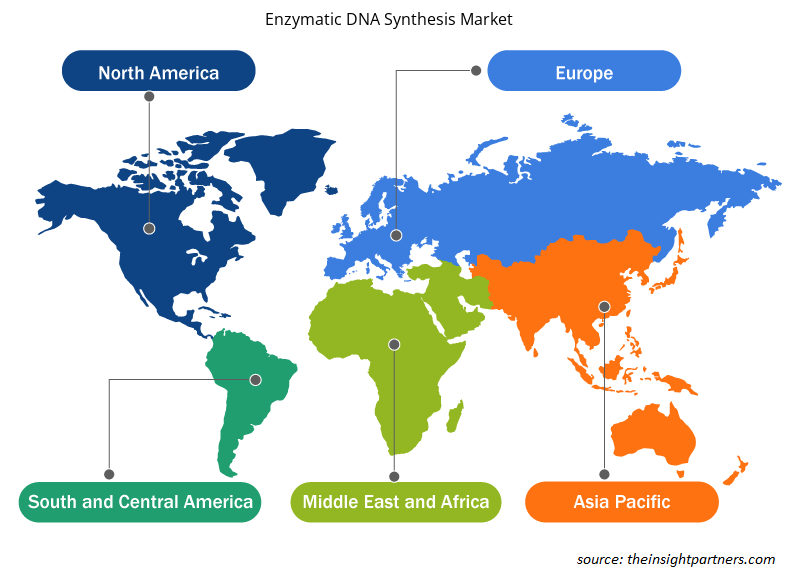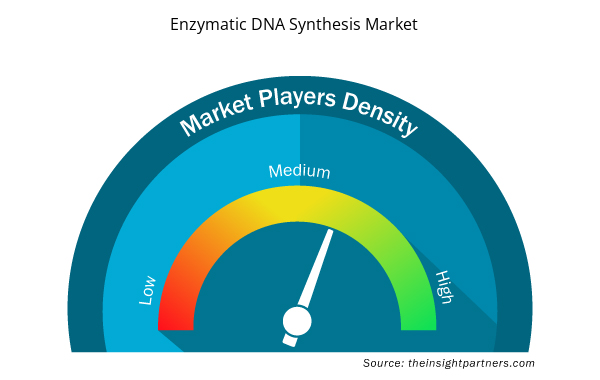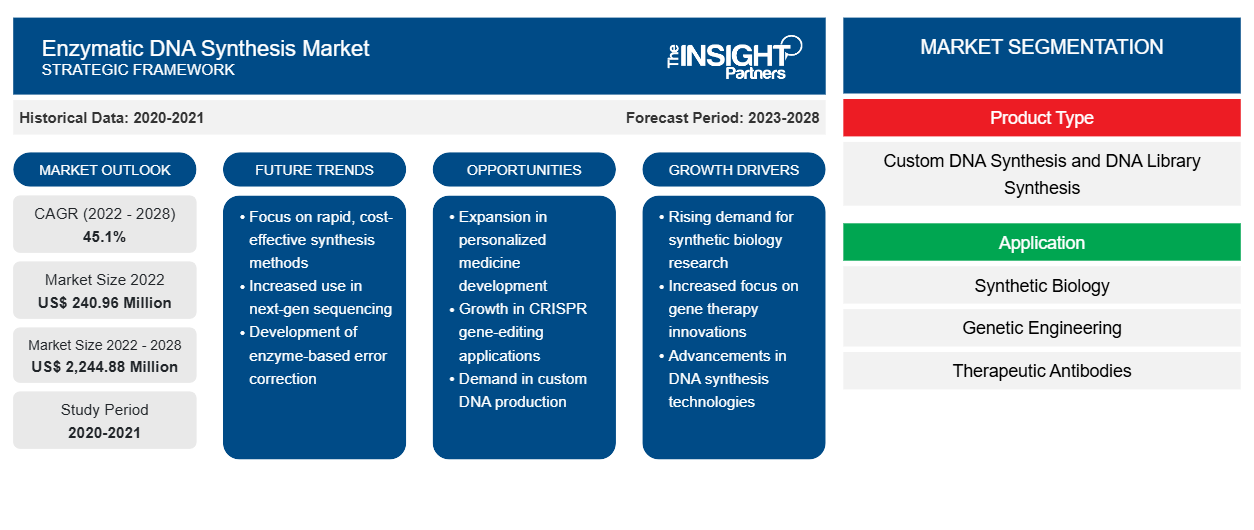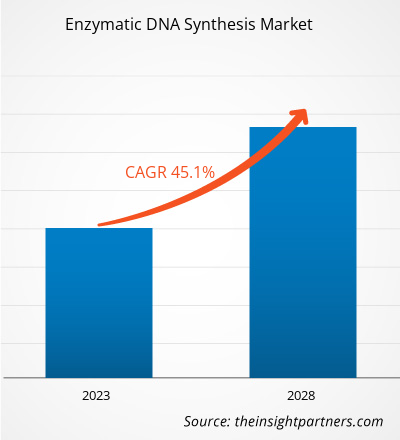[研究报告] 酶法DNA合成市场预计将从2022年的2.4096亿美元增长到2028年的22.4488亿美元;预计2022年至2028年的复合年增长率为45.1%。
酶促 DNA 合成是一种成熟的 DNA 合成技术,可用于合成生物学、基因工程、治疗性抗体生产、疫苗设计和其他先进的生物程序。事实证明,它还有助于维护 DNA 库和合成定制 DNA 分子。
酶法 DNA 合成市场洞察
遗传疾病患病率上升推动酶促 DNA 合成市场增长
唐氏综合症、自闭症谱系障碍、癌症、糖尿病、囊性纤维化和镰状细胞性贫血是几种常见的遗传性疾病。根据全球基因,已发现 10,000 多种不同的遗传病和罕见病,约 4 亿人患有罕见病。一些遗传病会在出生时引起症状,而另一些遗传病会随着时间的推移而发展。全球遗传病负担似乎正在增加。根据美国医疗机构美国国家生物技术信息中心 (NCBI) 的数据,截至 2021 年 11 月,9.4% 的儿科患者被确诊患有遗传病,其中 44.7% 为重症新生儿。此外,美国有 1,317 万患者患有独特的遗传病。根据美国疾病控制与预防中心 (CDC) 2022 年的报告,镰状细胞病影响约 100,000 名美国人,每 356 名非裔美国人中就有 1 名患有镰状细胞病。囊性纤维化是另一种全球常见的遗传病,在美国影响约 30,000 人,每年约有 1,000 例新病例接受治疗。酶促 DNA 合成是一种成熟的 DNA 合成技术,可用于合成生物学、基因工程和治疗性抗体研究。与酶促测定相结合,DNA 合成显示出更大的诊断可能性。这种方法提供了有关高危人群的重要信息,并帮助他们就疾病诊断和药物做出重要决定。因此,随着全球遗传疾病患病率的上升,人们越来越意识到早期发现这些遗传缺陷的必要性,这推动了酶促 DNA 合成市场的增长
定制此报告以满足您的需求
您可以免费定制任何报告,包括本报告的部分内容、国家级分析、Excel 数据包,以及为初创企业和大学提供优惠和折扣
- 获取此报告的关键市场趋势。这个免费样品将包括数据分析,从市场趋势到估计和预测。
高成本和复杂程序阻碍酶促 DNA 合成市场的增长
酶法 DNA 合成技术还不够成熟,在推广使用之前还需要进一步优化。大多数技术都基于天然存在的酶末端脱氧核苷酸转移酶 (TdT),该酶在生物系统中用于向 DNA 序列添加新碱基。基于 TdT 的方法比化学方法有所改进,因为它避免了产生危险废物。然而,这种酶的高成本和低准确性阻碍了它在体外 DNA 合成中的使用。TdT 酶过于宽松,添加错误碱基的次数比它应该添加的次数要多。因此,基于 TdT 的寡核苷酸有更多的序列错误,可能需要相同甚至更多的合成后质量控制步骤,从而增加了合成过程的时间和成本。在使用这种酶时,科学家需要添加更多的试剂来构建他们的目标序列,这进一步增加了整个合成过程的成本。使用 TdT 获得的合成 DNA 的每个碱基的成本比传统合成的遗传材料高得多。因此,高成本和复杂的程序限制了酶法 DNA 合成市场的增长。
基于产品类型的洞察
根据产品类型,酶法 DNA 合成市场细分为定制 DNA 合成和 DNA 库合成。DNA 库合成细分市场在 2021 年占据最大市场份额。此外,预计定制 DNA 合成细分市场在预测期内(2022-2028 年)的复合年增长率最高。
基于应用的洞察
根据应用,酶法 DNA 合成市场细分为合成生物学、 基因工程、治疗性抗体、疫苗设计和其他应用。合成生物学领域在 2021 年占据了最大的市场份额。治疗性抗体应用的酶法 DNA 合成市场预计在预测期内以最高的复合年增长率增长。
基于最终用户的洞察
根据最终用户,酶法 DNA 合成市场细分为学术和研究机构、生物技术和制药公司、诊断实验室等。生物技术和制药公司部门在 2021 年占据了最大的市场份额。预计学术和研究机构部门在预测期内(2022-2028 年)的复合年增长率最高。
酶促 DNA 合成市场区域洞察
Insight Partners 的分析师已详细解释了预测期内影响酶促 DNA 合成市场的区域趋势和因素。本节还讨论了北美、欧洲、亚太地区、中东和非洲以及南美和中美洲的酶促 DNA 合成市场细分和地理位置。

- 获取酶促 DNA 合成市场的区域特定数据
酶促 DNA 合成市场报告范围
| 报告属性 | 细节 |
|---|---|
| 2022 年市场规模 | 2.4096亿美元 |
| 2028 年市场规模 | 22.4488亿美元 |
| 全球复合年增长率(2022 - 2028) | 45.1% |
| 史料 | 2020-2021 |
| 预测期 | 2023-2028 |
| 涵盖的领域 | 按产品类型
|
| 覆盖地区和国家 | 北美
|
| 市场领导者和主要公司简介 |
|
酶促 DNA 合成市场参与者密度:了解其对业务动态的影响
酶促 DNA 合成市场正在快速增长,这得益于终端用户需求的不断增长,而这些需求又源于消费者偏好的不断变化、技术进步以及对产品优势的认识不断提高等因素。随着需求的增加,企业正在扩大其产品范围,进行创新以满足消费者的需求,并利用新兴趋势,从而进一步推动市场增长。
市场参与者密度是指在特定市场或行业内运营的企业或公司的分布情况。它表明在给定市场空间中,相对于其规模或总市场价值,有多少竞争对手(市场参与者)存在。
在酶法 DNA 合成市场运营的主要公司有:
- Telesis Bio公司
- 埃沃奈特克斯
- 安萨生物技术有限公司
- 卡梅纳生物
- 金斯瑞生物科技股份有限公司
免责声明:上面列出的公司没有按照任何特定顺序排列。

- 了解酶促 DNA 合成市场的主要参与者概况
基于技术的见解
根据技术,酶法 DNA 合成市场细分为 SOLA、CRISPR、PCR 等。PCR 部分在 2021 年占有最大份额,预计在预测期内将继续保持类似的趋势。另一方面,CRISPR 部分预计将在预测期内实现最高的复合年增长率。
酶促 DNA 合成市场并购中各公司主要采用的策略。以下列出了主要市场参与者的一些最新进展:
- 2022 年 4 月,GenScript 在年度 Built With Biology 全球会议上推出了业界首款最高通量 DNA 合成半导体芯片。这款高密度 DNA 合成芯片采用 GenScript 专有的微型半导体芯片技术开发,可同时合成 840 万个独特的寡核苷酸。
- 2022 年 4 月,Evonetix Ltd 获得了专利 EP3551331B1,该专利涉及其专有的 DNA 合成热控制技术以及其硅片在欧洲的设计和制造。除了扩展 Evonetix 的知识产权组合外,该专利还被视为该公司开发台式 DNA 合成平台战略的关键一步。
- 2022 年 3 月,Molecular Assemblies, Inc. 在新投资者 Casdin Capital 以及所有主要 A 轮投资者(安捷伦科技、iSelect Fund、Codexis、LYFE Capital 和 Argonautic Ventures)的参与下筹集了 2580 万美元的 B 轮融资。该公司打算利用融资所得启动一项关键客户计划,并推进公司专有的全酶法 DNA 合成技术实现早期商业化。
- 2021年11月,DNA Script获得美国国立卫生研究院(NIH)国家人类基因组研究所(NHGRI)220万美元的资助,用于支持开发能够酶促打印合成DNA和RNA的下一代打印机。
公司简介
- Telesis Bio公司
- 埃沃奈特克斯
- 安萨生物技术有限公司
- 卡梅纳生物
- 金斯瑞生物科技股份有限公司
- 分子组装
- DNA脚本
- 触摸灯
- 泓迅科技
- Twist 生物科学
- 历史分析(2 年)、基准年、预测(7 年)及复合年增长率
- PEST 和 SWOT 分析
- 市场规模价值/数量 - 全球、区域、国家
- 行业和竞争格局
- Excel 数据集



Report Coverage
Revenue forecast, Company Analysis, Industry landscape, Growth factors, and Trends

Segment Covered
This text is related
to segments covered.

Regional Scope
North America, Europe, Asia Pacific, Middle East & Africa, South & Central America

Country Scope
This text is related
to country scope.
常见问题
Enzymatic DNA synthesis (EDS) offers significant advantages in terms of accessibility and convenience, changing the pace and control of iteration and innovation with less environmental impact. The enzymes involved in DNA replication act coordinated to synthesize both leading and lagging strands of DNA simultaneously at the replication fork. Purported benefits of enzymatic synthesis include the ability to avoid the use of harsh chemical substances (which often result in toxic waste) and an ever-increasing ability to produce longer and longer strands of DNA, which in turn not only leads to a "more green" form of DNA synthesis, but also some incredibly powerful new uses for the longer DNA chains (e.g., vaccines, therapeutics, and data storage).
The factors that are driving the growth of the enzymatic DNA synthesis market are the rising prevalence of genetic disorders and surging number of product launches. Also, the growing demand for enzymatic DNA synthesis procedures is expected to provide opportunity for the enzymatic DNA synthesis market in forecasted period.
The enzymatic DNA synthesis market majorly consists of the players, such as Telesis Bio Inc, Evonetix, Ansa Biotechnologies, Inc., Camena Bio, GenScript Biotech Corp., Molecular Assemblie, DNA Script, Touchlight, Synbio Technologies, and Twist Bioscience.
The enzymatic DNA synthesis market is estimated to be valued at US$ 240.96 million in 2022.
The CAGR value of the enzymatic DNA synthesis market during the forecasted period of 2022-2028 is 45.1%.
The Asia Pacific region is expected to be the fastest-growing region in the enzymatic DNA synthesis market over the forecast period due to increasing government investment to provide healthcare facilities, growing advancements in healthcare infrastructure, greater adoption of advanced technologies, and rising healthcare spending in countries such as China, Japan, and India.
The enzymatic DNA synthesis market is expected to be valued at US$ 2,244.88 million in 2028.
The DNA library synthesis segment held the largest share of the market in 2022, owing to the various advantages offered by DNA library synthesis such as systematic, unbiased investigations such as high-throughput screening for discovery biology, directed evolution for protein engineering, and in vitro molecular optimization to generate mutant proteins with improved or novel properties. However, the custom DNA synthesis segment is estimated to register the highest CAGR in the market during the forecast period.
Trends and growth analysis reports related to Life Sciences : READ MORE..
The List of Companies - Enzymatic DNA Synthesis Market
- Telesis Bio Inc
- Evonetix
- Ansa Biotechnologies, Inc.
- Camena Bio
- GenScript Biotech Corp.
- Molecular Assemblies
- DNA Script
- Touchligh
- Synbio Technologies
- Twist Bioscience
The Insight Partners performs research in 4 major stages: Data Collection & Secondary Research, Primary Research, Data Analysis and Data Triangulation & Final Review.
- Data Collection and Secondary Research:
As a market research and consulting firm operating from a decade, we have published and advised several client across the globe. First step for any study will start with an assessment of currently available data and insights from existing reports. Further, historical and current market information is collected from Investor Presentations, Annual Reports, SEC Filings, etc., and other information related to company’s performance and market positioning are gathered from Paid Databases (Factiva, Hoovers, and Reuters) and various other publications available in public domain.
Several associations trade associates, technical forums, institutes, societies and organization are accessed to gain technical as well as market related insights through their publications such as research papers, blogs and press releases related to the studies are referred to get cues about the market. Further, white papers, journals, magazines, and other news articles published in last 3 years are scrutinized and analyzed to understand the current market trends.
- Primary Research:
The primarily interview analysis comprise of data obtained from industry participants interview and answers to survey questions gathered by in-house primary team.
For primary research, interviews are conducted with industry experts/CEOs/Marketing Managers/VPs/Subject Matter Experts from both demand and supply side to get a 360-degree view of the market. The primary team conducts several interviews based on the complexity of the markets to understand the various market trends and dynamics which makes research more credible and precise.
A typical research interview fulfils the following functions:
- Provides first-hand information on the market size, market trends, growth trends, competitive landscape, and outlook
- Validates and strengthens in-house secondary research findings
- Develops the analysis team’s expertise and market understanding
Primary research involves email interactions and telephone interviews for each market, category, segment, and sub-segment across geographies. The participants who typically take part in such a process include, but are not limited to:
- Industry participants: VPs, business development managers, market intelligence managers and national sales managers
- Outside experts: Valuation experts, research analysts and key opinion leaders specializing in the electronics and semiconductor industry.
Below is the breakup of our primary respondents by company, designation, and region:

Once we receive the confirmation from primary research sources or primary respondents, we finalize the base year market estimation and forecast the data as per the macroeconomic and microeconomic factors assessed during data collection.
- Data Analysis:
Once data is validated through both secondary as well as primary respondents, we finalize the market estimations by hypothesis formulation and factor analysis at regional and country level.
- Macro-Economic Factor Analysis:
We analyse macroeconomic indicators such the gross domestic product (GDP), increase in the demand for goods and services across industries, technological advancement, regional economic growth, governmental policies, the influence of COVID-19, PEST analysis, and other aspects. This analysis aids in setting benchmarks for various nations/regions and approximating market splits. Additionally, the general trend of the aforementioned components aid in determining the market's development possibilities.
- Country Level Data:
Various factors that are especially aligned to the country are taken into account to determine the market size for a certain area and country, including the presence of vendors, such as headquarters and offices, the country's GDP, demand patterns, and industry growth. To comprehend the market dynamics for the nation, a number of growth variables, inhibitors, application areas, and current market trends are researched. The aforementioned elements aid in determining the country's overall market's growth potential.
- Company Profile:
The “Table of Contents” is formulated by listing and analyzing more than 25 - 30 companies operating in the market ecosystem across geographies. However, we profile only 10 companies as a standard practice in our syndicate reports. These 10 companies comprise leading, emerging, and regional players. Nonetheless, our analysis is not restricted to the 10 listed companies, we also analyze other companies present in the market to develop a holistic view and understand the prevailing trends. The “Company Profiles” section in the report covers key facts, business description, products & services, financial information, SWOT analysis, and key developments. The financial information presented is extracted from the annual reports and official documents of the publicly listed companies. Upon collecting the information for the sections of respective companies, we verify them via various primary sources and then compile the data in respective company profiles. The company level information helps us in deriving the base number as well as in forecasting the market size.
- Developing Base Number:
Aggregation of sales statistics (2020-2022) and macro-economic factor, and other secondary and primary research insights are utilized to arrive at base number and related market shares for 2022. The data gaps are identified in this step and relevant market data is analyzed, collected from paid primary interviews or databases. On finalizing the base year market size, forecasts are developed on the basis of macro-economic, industry and market growth factors and company level analysis.
- Data Triangulation and Final Review:
The market findings and base year market size calculations are validated from supply as well as demand side. Demand side validations are based on macro-economic factor analysis and benchmarks for respective regions and countries. In case of supply side validations, revenues of major companies are estimated (in case not available) based on industry benchmark, approximate number of employees, product portfolio, and primary interviews revenues are gathered. Further revenue from target product/service segment is assessed to avoid overshooting of market statistics. In case of heavy deviations between supply and demand side values, all thes steps are repeated to achieve synchronization.
We follow an iterative model, wherein we share our research findings with Subject Matter Experts (SME’s) and Key Opinion Leaders (KOLs) until consensus view of the market is not formulated – this model negates any drastic deviation in the opinions of experts. Only validated and universally acceptable research findings are quoted in our reports.
We have important check points that we use to validate our research findings – which we call – data triangulation, where we validate the information, we generate from secondary sources with primary interviews and then we re-validate with our internal data bases and Subject matter experts. This comprehensive model enables us to deliver high quality, reliable data in shortest possible time.


 获取此报告的免费样本
获取此报告的免费样本